Malvar
Malvar, officially the Municipality of Malvar (Tagalog: Bayan ng Malvar), is a 2nd class municipality in the province of Batangas, Philippines.
Malvar | |
|---|---|
| Municipality of Malvar | |
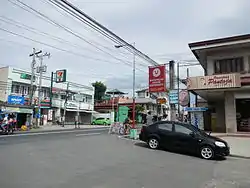 Street in Malvar | |
 Seal | |
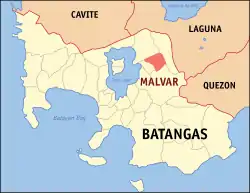 Map of Batangas with Malvar highlighted | |
OpenStreetMap | |
.svg.png.webp) Malvar Location within the Philippines | |
| Coordinates: 14°02′30″N 121°09′30″E | |
| Country | Philippines |
| Region | Calabarzon |
| Province | Batangas |
| District | 3rd district |
| Founded | January 10, 1919 |
| Named for | Miguel Malvar |
| Barangays | 15 (see Barangays) |
| Government | |
| • Type | Sangguniang Bayan |
| • Mayor | Cristeta C. Reyes |
| • Vice Mayor | Alberto C. Lat |
| • Representative | Ma. Theresa V. Collantes |
| • Municipal Council | Members |
| • Electorate | 38,118 voters (2022) |
| Area | |
| • Total | 33.00 km2 (12.74 sq mi) |
| Elevation | 213 m (699 ft) |
| Highest elevation | 354 m (1,161 ft) |
| Lowest elevation | 24 m (79 ft) |
| Population (2020 census)[3] | |
| • Total | 64,379 |
| • Density | 2,000/km2 (5,100/sq mi) |
| • Households | 17,064 |
| Economy | |
| • Income class | 2nd municipal income class |
| • Poverty incidence | 9.40 |
| • Revenue | ₱ 388.1 million (2020) |
| • Assets | ₱ 1,259 million (2020) |
| • Expenditure | ₱ 204.1 million (2020) |
| • Liabilities | ₱ 159.9 million (2020) |
| Service provider | |
| • Electricity | Batangas 2 Electric Cooperative (BATELEC 2) |
| Time zone | UTC+8 (PST) |
| ZIP code | 4233 |
| PSGC | |
| IDD : area code | +63 (0)43 |
| Native languages | Tagalog |
| Website | www |
Located 37 kilometers (23 mi) from Batangas City and 68 kilometers (42 mi) south of Manila and accessible by the STAR Tollway, Malvar is surrounded by Tanauan City to the north, Santo Tomas City to the east, Lipa City to the south and Balete to the west. With the expansion of Metro Manila, Malvar is now part of the Manila conurbation (which reaches Lipa City).
Etymology
The municipality was named after General Miguel Malvar, a native of Santo Tomas, Batangas and one of the last Filipino generals to surrender to the Americans during the Philippine-American War in 1902.
Its previous name before it became a municipality is Luta, derived from the name of Dayangdayang Luta, the youngest daughter of Datu Banga (a descendant of Datu Puti), who ruled the area. She was the most beautiful lady in the place who was loved and cherished by the inhabitants. She fell in love with a Chinese named Ling and was about to be married when her elder sister Kampupot took interest in him. However, out of the treachery and jealousy of her sister, she was executed and died in the arms of her Chinese lover. From then on, the place was named Luta in her honor.[5]
History

Malvar traces its origin to Luta, which was once a barrio of Lipa. According to Ferdinand Blumentritt who wrote many articles about Philippine history which were published in Boletin de la Sociedad Geografica in Madrid, Spain in 1866, Malvar's history dates back to 1300 AD when Datu Puti, one of the ten legendary datus who escaped from Sultan Makatunao of Borneo, settled in what is now the province of Batangas. His descendants inhabited present-day Laguna, Cavite, Bicol, and Luta.
Luta's march toward becoming a municipality could never be ignored. For this is where the seeds and the sentiments of becoming one were sown. This is where the Samahang Mag-aararo, the acknowledged pioneers of this movement was organized. They were Mariano R. Lat, Gregorio Leviste, Miguel L. Aranda, Simeon Esleigue, Constancio Manalo, Pedro Lat-Torres, Nicasio Gutierrez, Gregorio Villapando, Estanislaw Lat, Pelagio Wagan, Sebastian Trinidad and Julian Lantin. Through its dynamic organizers and members, the first steps to make the locality a municipality were made. It was in Luta where the seat of the Municipal Government was situated.[5]
With their (The Samahang Mag-aararo) devotion, patience, and perseverance and with the help of the Interior Secretary Teodoro Kalaw, Malvar was finally created a municipality by an executive order issued by acting Governor-General Charles Yeater on December 16, 1918. The proclamation took effect on January 10, 1919, the day the municipality was inaugurated.[6] It initially included the adjoining barrios of Payapa, Kalikangan (Caligañgan), San Gallo (San Galo), and Bilukaw. As time went by, these original barrios were divided and were given other names. Payapa was divided and became San Fernando, Santiago, and Bagong Pook. Kalikakan became the barrios of San Andres and San Juan. San Gallo became the barrios of San Pioquinto, San Pedro (including Sitio Calejon) and Bilucaw became San Isidro and Bilucao. These names given to each barrio were based on the names of the locality's most powerful or honored man.
Geography
Malvar is located at 14°02′30″N 121°09′30″E.
According to the Philippine Statistics Authority, the municipality has a land area of 33.00 square kilometers (12.74 sq mi) [7] constituting 1.06% of the 3,119.75-square-kilometer (1,204.54 sq mi) total area of Batangas.
Barangays
Malvar is politically subdivided into 15 barangays.[8] Each barangay consists of puroks and some have sitios.
| PSGC | Barangay | Population | ±% p.a. | |||
|---|---|---|---|---|---|---|
| 2020[3] | 2010[9] | |||||
| 041017001 | Bagong Pook | 3.2% | 2,049 | 1,932 | 0.59% | |
| 041017002 | Bilucao (San Isidro Western) | 2.9% | 1,842 | 1,587 | 1.50% | |
| 041017003 | Bulihan | 3.6% | 2,311 | 1,472 | 4.61% | |
| 041017004 | San Gregorio | 2.1% | 1,336 | 1,138 | 1.62% | |
| 041017005 | Luta del Norte | 6.2% | 3,989 | 3,053 | 2.71% | |
| 041017006 | Luta del Sur | 7.2% | 4,661 | 3,685 | 2.38% | |
| 041017008 | Poblacion | 11.9% | 7,632 | 7,049 | 0.80% | |
| 041017012 | San Andres | 4.8% | 3,074 | 2,869 | 0.69% | |
| 041017013 | San Fernando | 8.5% | 5,446 | 4,349 | 2.27% | |
| 041017015 | San Isidro East | 2.5% | 1,603 | 1,524 | 0.51% | |
| 041017016 | San Juan | 4.8% | 3,069 | 2,907 | 0.54% | |
| 041017017 | San Pedro II (Western) | 3.1% | 1,988 | 1,499 | 2.86% | |
| 041017018 | San Pedro I (Eastern) | 3.8% | 2,448 | 1,681 | 3.83% | |
| 041017019 | San Pioquinto | 11.0% | 7,068 | 5,227 | 3.06% | |
| 041017020 | Santiago | 12.0% | 7,754 | 5,980 | 2.63% | |
| Total | 64,379 | 45,952 | 3.43% | |||
Climate
| Climate data for Malvar | |||||||||||||
|---|---|---|---|---|---|---|---|---|---|---|---|---|---|
| Month | Jan | Feb | Mar | Apr | May | Jun | Jul | Aug | Sep | Oct | Nov | Dec | Year |
| Average high °C (°F) | 27 (81) |
29 (84) |
30 (86) |
32 (90) |
30 (86) |
29 (84) |
28 (82) |
27 (81) |
27 (81) |
28 (82) |
28 (82) |
27 (81) |
29 (83) |
| Average low °C (°F) | 19 (66) |
19 (66) |
19 (66) |
21 (70) |
23 (73) |
23 (73) |
23 (73) |
23 (73) |
23 (73) |
22 (72) |
20 (68) |
19 (66) |
21 (70) |
| Average precipitation mm (inches) | 11 (0.4) |
13 (0.5) |
14 (0.6) |
32 (1.3) |
101 (4.0) |
142 (5.6) |
208 (8.2) |
187 (7.4) |
175 (6.9) |
131 (5.2) |
68 (2.7) |
39 (1.5) |
1,121 (44.3) |
| Average rainy days | 5.2 | 5.0 | 7.4 | 11.5 | 19.8 | 23.5 | 27.0 | 25.9 | 25.2 | 23.2 | 15.5 | 8.3 | 197.5 |
| Source: Meteoblue[10] | |||||||||||||
Demographics
| Year | Pop. | ±% p.a. |
|---|---|---|
| 1939 | 6,637 | — |
| 1948 | 7,787 | +1.79% |
| 1960 | 10,313 | +2.37% |
| 1970 | 14,169 | +3.22% |
| 1975 | 15,584 | +1.93% |
| 1980 | 18,028 | +2.96% |
| 1990 | 24,253 | +3.01% |
| 1995 | 27,771 | +2.57% |
| 2000 | 32,691 | +3.56% |
| 2007 | 41,730 | +3.42% |
| 2010 | 45,952 | +3.57% |
| 2015 | 56,270 | +3.93% |
| 2020 | 64,379 | +2.68% |
| Source: Philippine Statistics Authority[11][9][12][13] | ||
In the 2020 census, Malvar had a population of 64,379.[3] The population density was 2,000 inhabitants per square kilometer (5,200/sq mi).
Economy
Government
Local government
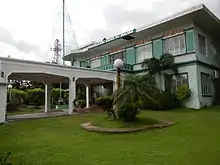
List of chief executive
- Gregorio Leviste: 1919-1922
- Simeon Esleigue: 1922-1924
- Julio Leviste: 1924-1930
- Benito Leviste: 1930–1939, 1945-1950
- Trinidad Leviste: 1939-1941
- Angel Leviste: 1941-1942
- Fidel Leviste: 1942-1944
- Eustacio Endaya: 1944–1945,1968-1980
- Benito Leviste: 1930–1939, 1945-1950
- Pedro Lat: 1951-1955
- Pedro Montecer: 1955-1959
- Isabelo Navarro: 1959[21]-1967
- Eustacio Endaya: 1944–1945,1968-1980
- Fermin Malabanan: 1980
- Maximo Reyes: 1980-1986
- Patricio Villegas: 1986-1998
- Teodora Villegas: 1998-2001
- Cristeta C. Reyes: 2001-2010
- Carlito D. Reyes, MD: 2010-2016
- Cristeta C. Reyes: 2016-2018
- Alberto C. Lat: 2018-2019
- Cristeta C. Reyes: 2019–present
Education
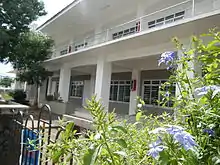
- Bagong Pook Elementary School (Bagong Pook)
- Bilucao Elementary School (Bilucao)
- Bulihan Elementary School(Bulihan)
- Don Julio Leviste Memorial Vocational High School (San Andres)
- Immaculate Conception Montessori School (Poblacion)
- Jose P. Laurel Polytechnic College (Poblacion)
- Luta Elementary School (Luta Sur)
- Malvar Central School (Poblacion)
- Malvar School of Arts and Trade (Poblacion)
- Miguel L. Aranda Memorial Elementary School (San Andres)
- Mother Hand Educational School (Poblacion)
- OB Montessori School (Sanpioquinto)
- Payapa Elementary School (Santiago)
- San Fernando Elementary School
- San Isidro National High School (San Isidro)
- San Pedro 1 Primary School
- San Pedro Elementary School (San Pedro)
- Sanpioquinto Elementary School (Sanpioquinto)
- Santiago National High School (Santiago)
- Southgate Institute of Malvar (Poblacion)
Health
Apart from the primary Rural Health Unit under DOH-Batangas, Mayor Carlito Reyes founded the Malvar Maternity Clinic a month after taking office. The clinic accepts emergency deliveries and is open 24 hours daily for obstetric and other immediate health services. The clinic has doctors on duty from 7 am to 11 pm on weekdays and around the clock on weekends. RHU personnel serve during the day. Nurses are on duty 24 hours daily, and a midwife is on duty on weeknights. An ambulance is available for patient transfers, and all services are free of charge.
Tourism
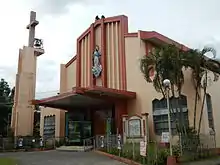
Calejon Falls, in Barangay San Gregorio (formerly known as Calejon), consists of two large waterfalls and two smaller ones. One of the larger falls is about 10 feet (3.0 m) high, with clear water falling into a shallow pool. One of the smaller falls is shower-like, while the other forms a series of small cascades. All the falls are in an area of about 300 square meters (360 sq yd).
The falls are located at the STAR Tollway Bulihan exit. From Manila, buses to Batangas City or Lipa City stop at Malvar. Jeepneys and tricycle service are also available from the town. The 5-kilometer (3.1 mi) stretch of road is smoothly paved. There are 300 concrete steps down the river at the falls.
The San Juan River, the longest river in Batangas, connects Lipa, and Tanauan and Santo Tomas and is a water source for vegetable and fish farms.
A recently emerged local attraction in the area is a mango farm known as Sa Manggahan.[22] Forty-five minutes away from Alabang, it is near the C-Joist Concrete Ventures Group plant. The country's third Thoroughbred race track (Metro Manila Turf Club Race Track) is in the municipality, as are the Immaculate Conception Parish Church of Malvar and the Miguel Malvar Monument at the Municipal Hall Grounds. The fiesta is celebrated every January 10.
Malvar is slowly establishing its reputation as a conference center in Batangas. In February 2013, the Lima Park Pavilion opened to the public with a concert by the Madrigal Singers. With a capacity of 1,000 the Lima Park Pavilion and Lima Park Hotel are located in Malvar's industrial park, the Lima Technology Center.
Landmarks
- Batangas State University - Jose P. Laurel Polytechnic College
- Immaculate Conception Parish Church of Malvar
- Metro Manila Turf Club Race Track
- Miguel Malvar Monument
Notable personalities
- Feliciano Leviste - politician; Batangas governor (1947-1972)
- Jose Antonio Leviste - politician; Batangas governor (1972-1980)
- Rey Publico - basketball player
- Admiral Artemio Abu - Commandant of the Philippine Coast Guard
References
- Municipality of Malvar | (DILG)
- "2015 Census of Population, Report No. 3 – Population, Land Area, and Population Density" (PDF). Philippine Statistics Authority. Quezon City, Philippines. August 2016. ISSN 0117-1453. Archived (PDF) from the original on May 25, 2021. Retrieved July 16, 2021.
- Census of Population (2020). "Region IV-A (Calabarzon)". Total Population by Province, City, Municipality and Barangay. Philippine Statistics Authority. Retrieved 8 July 2021.
- "PSA Releases the 2018 Municipal and City Level Poverty Estimates". Philippine Statistics Authority. 15 December 2021. Retrieved 22 January 2022.
- "History | Municipality of Malvar, Batangas". Retrieved 2021-02-24.
- Executive Order No. 56 (16 December 1918). Creating the Municipality of Malvar. Retrieved July 7, 2023.
- "Province: Batangas". PSGC Interactive. Quezon City, Philippines: Philippine Statistics Authority. Retrieved 12 November 2016.
- "Municipal: Malvar". PSGC Interactive. Quezon City, Philippines: Philippine Statistics Authority. Retrieved 8 January 2016.
- Census of Population and Housing (2010). "Region IV-A (Calabarzon)" (PDF). Total Population by Province, City, Municipality and Barangay. National Statistics Office. Retrieved 29 June 2016.
- "Malvar: Average Temperatures and Rainfall". Meteoblue. Retrieved May 5, 2020.
- Census of Population (2015). "Region IV-A (Calabarzon)". Total Population by Province, City, Municipality and Barangay. Philippine Statistics Authority. Retrieved 20 June 2016.
- Censuses of Population (1903–2007). "Region IV-A (Calabarzon)". Table 1. Population Enumerated in Various Censuses by Province/Highly Urbanized City: 1903 to 2007. National Statistics Office.
- "Province of Batangas". Municipality Population Data. Local Water Utilities Administration Research Division. Retrieved 17 December 2016.
- "Poverty incidence (PI):". Philippine Statistics Authority. Retrieved December 28, 2020.
- "Estimation of Local Poverty in the Philippines" (PDF). Philippine Statistics Authority. 29 November 2005.
- "2003 City and Municipal Level Poverty Estimates" (PDF). Philippine Statistics Authority. 23 March 2009.
- "City and Municipal Level Poverty Estimates; 2006 and 2009" (PDF). Philippine Statistics Authority. 3 August 2012.
- "2012 Municipal and City Level Poverty Estimates" (PDF). Philippine Statistics Authority. 31 May 2016.
- "Municipal and City Level Small Area Poverty Estimates; 2009, 2012 and 2015". Philippine Statistics Authority. 10 July 2019.
- "PSA Releases the 2018 Municipal and City Level Poverty Estimates". Philippine Statistics Authority. 15 December 2021. Retrieved 22 January 2022.
- Philippine News Agency (November 14, 1959). "Liberals win 5 more seats". The Manila Times. The Manila Times Publishing Company, Inc.
Isabelo Navarro, Nacionalista, wrested the local mayoralty seat from incumbent mayor Pedro Montecer.
- "Sa Manggahan Leisure Farms, Barangay San Pioquinto, Malvar, Batangas". Samanggahan.com. Archived from the original on April 5, 2012. Retrieved 2011-09-27.
